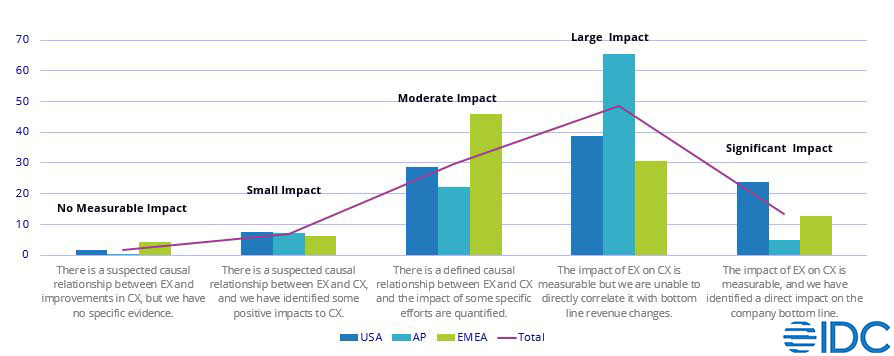The events of the last twelve to eighteen months have shown a spotlight on both employee productivity and employee experience. According to IDC’s Market Analysis Perspective: Worldwide Employee Experience Management Strategies, 2021, “a disrupted workforce accelerated changes at an exponential rate. Organizations had to quickly reinvent the way in which employees worked, creating the right technology experiences virtually and, importantly, maintaining or improving the corporate culture to ensure that workers felt cared for during a difficult time.”
Recent IDC research shows that those organizations that did invest in digital transformation (DX) technologies in 2020 enjoyed a 20% increase in employee productivity (IDC’s Future Enterprise Resiliency & Spending Survey Wave 6, July 2021.)
But employee productivity does not necessarily equate to a great employee experience in all cases (though a March 2020 Forbes article did note that a great experience can lead to improved productivity). So how does an improved employee experience contribute to better business outcomes? And in particular, does an improved employee experience (EX) contribute to a better customer experience (CX)?
85% of respondents to the IDC survey mentioned above agree that an improved employee experience and higher employee engagement translate to a better customer experience, higher customer satisfaction, and higher revenues for their organization. In fact, 62% said that there is a defined causal relationship between EX and CX and that the impact was “large” or “significant” and measurable. Over half (58%) indicated that customer satisfaction is a key metric in evaluating employee productivity. (See Productivity Metrics for a Global Hybrid Workforce.)
What impact on customer experience (CX) have you observed by improving your employee experience (EX) metrics?

Source: IDC, Relating Employee Experience to Customer Experience, July 2021
In another recent IDC survey, 30% of respondents said that improved customer experience is an important business driver behind the work transformation initiatives in their organization (IDC, Future of Work Survey, March 2021).
So, what does this mean for your organization?
First, if you have not already done so, you must establish a robust methodology to measure – and adjust – employee engagement and employee experience on a regular basis, in addition to any ongoing customer experience programs that your business may have implemented. Key metrics include employee satisfaction (e.g., eNPS), health and happiness metrics, diversity and inclusion index and indicators linking digital investments and employees’ behavior.
Some of the important factors that impact employee experience are:
- Transparency, trust, and communications from employers
- The availability of a frictionless, collaborative work environment with digital experiences embedded in the flow of work
- An organizational culture of belonging and inclusion
- Employee listening, engagement and recognition from management and peers
- Career development and upskilling opportunities
- Demonstrated corporate social responsibility
Finally, it goes without saying that a great employee experience can lead to increased talent acquisition and retention. This is especially critical as the world adjusts to a new hybrid work reality that removes some of the geographical limitations on talent, leading to increased competition for that talent.
So, take stock! A great employee experience leads to happier customers – and competitive advantage.
Join IDC’s Holly Muscolino and Amy Loomis, Ph.D. in our Sept. 23 webinar on how to sustain a hybrid work model over time. Learn to successfully connect your workforce whether they are in office or remote.
If you would like to learn more about the Future of Work or other IDC’s “Future of X” practices, visit our website at https://www.idc.com/FoX.




